Order of Battle: The XIX Army Corps The French Armies in Africa were the Armee d’Afrique and the Troupes de Marine (called La Coloniale in 1900).
Troupes de Marine (La Coloniale)
The Troupes de Marine was used in West African Soudan in 1880’s and 1890’s that brought them as far as the Algerian border. They will not be examined in this article, as they were not used on the Algero Moroccan border.
The Tirailleurs Senegalais will also not be studied here. Tirailleurs Senegalais were later sent to reinforce Algeria when the Tirailleur Algeriens were bled off to support the occupation of Morocco.
Armee d’Afrique
The Armee d’Afrique was the main instrument in Frances occupation of Northern Africa. The four, mostly European, units of the Armee d’Afrique were the:
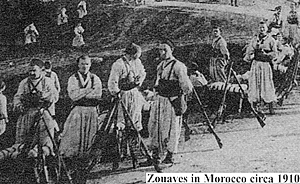 Zouaves
Zouaves
Infanterie Legere d’Afrique (known as colloquially as Battalion d’Afrique or Bat d’Af and less formally as Les Joyeux)
Legion Etrangere
Chasseurs d’Afrique
The backbone of the French imperialist forces were its native African troops.
- Tirailleurs Algeriens
Spahis Algeriens
Compagnies Sahariennes
Goums
European Regiments
Zouaves: The Zouaves were the elite units of the Armee d’Afrique comprising both French enlistees and locally raised recruits. Zouaves saw considerable action in the initial conquering of Algeria where they served with distinction earning the reputation of an elite unit. After the Franco Prussian War, the Zouaves were reformed in Algeria as 4 regiments.
Organization: Each Zouave regiment contained 4 battalions in North Africa, with a 5th battalion in France serving with the Metropolitan Army along with another battalion of reservists, designated as the 11th battalion. Prior to the Franco Prussian war they were an all-volunteer regiment but in the early 1870’s they made the transition to largely conscript regiments. During the 1880’s they were used less in purely colonial engagements and tended to serve with and when the Metropolitan army was used, such as in Tunisia. The draft term was eventually lowered to 1 year and attracted Italian and Spanish residents of Algeria and Tunisia who from 1889 were granted French Citizenship after service.
Battalion strength in 1900 was 598 Other Ranks and NCO’s with 14 Officers. These were divided into 4 companies of two platoons. Each platoon was further divided into two sections. Nominal “in field” strength of a company was about 120 men and NCO’s with about 3 officers.
Uniforms: Zouave uniforms were Arabic in design. The hallmark of the Zouaves were it’s flashy colorful uniforms of the short Zouave style jacket, baggy pantaloons and red soft.
Hat: Chechia, a red shapeless fez. This was wrapped in a white turban that was often not worn in the field.
Jacket: Short dark-blue waist length jacket and vest. Lined white. Red piping on the collar and down the front.
False pocket with looped shaped braiding colored to designate the regiment.
- 1er Dark Red
2e White
3e Yellow
4e Dark Blue
A blue-gray hooded overcoat was issued for cold weather.
Pant: Dress issue was bright red baggy pantaloon style pants with blue braided piping down the outside leg. These were often traded for plain white sarouel pantaloons for hot weather wear. A long light-blue sash, a sort of wide waistband was wrapped around the top of the pants. The pants are shin length and cloth gaiters are worn below this, replaced by leather gaiters around 1903.
Equipment: Zouaves were issued the Lebel Rifle, 1888 Pouches, haversack and canteen.
Infanterie Legere d’Afrique (Bat d’Af)
The Infanterie Legere was comprised of penal battalions employing harsh discipline. Much of what has gone down in folklore as pertaining to the Foreign Legion discipline actually finds its history in the Bat d ‘Af. The Bat d’Af are often confused with the Compagnies Disciplinaires and sectiones d’exclus of which they were neither. The compagnies disciplinaires, as their name suggests, were men serving punitive disciplinary terms who were returned upon completion of their correction, to their originating units. Sections d’exclus were those considered unfit for service and subject to extreme punishment. They were considered unfit to bear arms and were discharged upon completion. The Bat d’Af were originally recruited from men who had served a term in the compagnies disciplinaires but had not finished their prior term of enlistment. Also accepted were those released from prison sentences of less than three months but who had not yet served their term of conscription.
There was also a hard corps of volunteers, both rankers and officers who sought the adventures that service in North Africa was bound to provide them and which garrison duty in France did not. This category by the end of the 19th century, became the predominant one. Care was taken not to accept anyone convicted of serious crimes (most were pimps) and the army became quite selective of the officers.
The Bat d’Af were used in dangerous areas of North Africa in grueling conditions require the fittest of men. They were driven to the point of total exhaustion, conditions that required brutal discipline. However, in combat, their conduct was second to none and remained exemplary during the colonial period.
Organization: A single regiment of 5 battalions. Each battalion was nominally 1000 men with 28 officers. By the end of the 19th century they fielded about 6 companies each of about 120 -130 men with 3 officers per company. They were further divided into 2 platoons of two detachments each.
Uniforms
Hat: Kepi with hunting horn badge, usually covered in a white kepi cover with neck flap.
Jacket: A white fatigue shirt, (1882-issue bourgeron). Blue-Gray capote (legion style) worn over the fatigue shirt. From about 1903 some replacements started arriving in Oran with the new Khaki colonial uniform. These were often mixed with white pants and the complete change over did not take place until WWI.
Pants: White fatigue pants. Light blue sash. Cloth or leather gaiters.
Equipment: Lebel Rifle.1888 Pouches, haversack and canteen.
Legion Etrangèr (The French Foreign Legion)
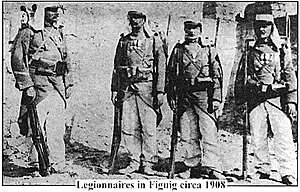 The French Foreign Legion are perhaps the most well known and most written about unit of the French Army. The Legion were used for the toughest of assignments where there brutal discipline kept them together when many other units would have fallen apart. There ability to survive grueling marches, in thick uniforms under the murderous Algerian desert sun gave rise to the motto March or Die. A literal end for those who couldn’t keep up. The biggest killer of the Legion in Algeria was disease, which reduced isolated fort garrisons by as much as 75% In some cases, and 50% was not unusual
The French Foreign Legion are perhaps the most well known and most written about unit of the French Army. The Legion were used for the toughest of assignments where there brutal discipline kept them together when many other units would have fallen apart. There ability to survive grueling marches, in thick uniforms under the murderous Algerian desert sun gave rise to the motto March or Die. A literal end for those who couldn’t keep up. The biggest killer of the Legion in Algeria was disease, which reduced isolated fort garrisons by as much as 75% In some cases, and 50% was not unusual
Organization: There were two regiments of the Legion at this time, each of four battalions with eight companies. The companies consisted of two platoons each of two sections. The field strength of a company was between 100 and 120 men. Three line officers per company.
Uniform: Same as the Infanterie Legere whose uniforms were based on those of the Legion. The difference being in the cap badge, which for the legion was the five-plumed grenade.
Chasseurs d’Afrique
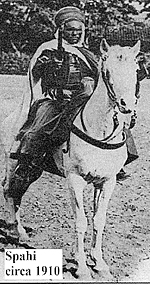 The Chasseurs d’Afrique were used in force along the Moroccan border region to patrol the supply lines (which ran parallel to the border) and used for reconnaissance and pursuing raids back into Moroccan territory. Chasseurs were originally intended to dismount and fight on foot as mounted light infantry. In reality they tended to fight mounted like “real cavalry” which is certainly what they considered themselves to be. They were armed with saber and carbines. They patrolled the border and pursued many razzias back in to Morocco, attacking the tribes at their camps.
The Chasseurs d’Afrique were used in force along the Moroccan border region to patrol the supply lines (which ran parallel to the border) and used for reconnaissance and pursuing raids back into Moroccan territory. Chasseurs were originally intended to dismount and fight on foot as mounted light infantry. In reality they tended to fight mounted like “real cavalry” which is certainly what they considered themselves to be. They were armed with saber and carbines. They patrolled the border and pursued many razzias back in to Morocco, attacking the tribes at their camps.
Organization: There were six regiments of Chasseur d’Afrique; each regiment contained six squadrons of two troops each. The field strength of a troop was usually around 60 men.
Uniforms
Hat: Dark-blue kepi with red trim. White kepi cover with neck flap was often worn. Jacket: Blue jacket.
Pants: Blue-Gray pants, red stripe for officers. White cloth gaiters.
Equipment: Black leather, Lebel Carbine with bayonet. Saber. Grey horses when ever possible.
North African Regiments
Tirailleurs Algeriens
The Indigenous North African regiments raised by France consist of the Tirailleurs Algeriens and the Regiments de Spahis Algeriens. There were also Tunisien and later, Moroccan versions of these units. The Tirailleurs were regular infantry raised from locals, and used as supporting units throughout Algeria. They were typically used in small detachment in this period. The 1st and 2nd regiments were used extensively to capture the southern oases between 1900 and 1903. By 1903 they were finding themselves in many border skirmishes and being used in the invasion proper in 1907.
Organization: Each regiment contained 6 battalions prior to 1907, after which the regiments underwent significant expansion. Battalion strength was between 1200 and 1400 men with mostly French officers. I have found it hard to pin down precise book strength because of almost constantly increasing numbers and re-organization of battalions in this period. There were four companies to each battalion, but as noted, the Tirailleurs almost always fought in detachments throughout this period. These appear to have nominally consisted of in the order of 120 men in two platoons of two detachments.
Uniforms: Tirailleur uniforms were Turkish in design, very similar to those of the Zouaves.
Hat: Chechia, bright red with a yellow tassel. This was wrapped in a white turban that was often not worn in the field.
Jacket: Short sky-blue waist length jacket lined white. Yellow piping on the collar and down the front. False pocket with colored (looped shape) braiding colored to designate the regiment.1er Red; 2e White;3e Yellow;4e Blue
Pant: Dress issue was sky blue baggy sarouel pants with yellow braided piping down the outside leg. These were sometimes traded for plain white pants for hot weather wear. A long bright red sash, a sort of wide waistband was wrapped around the top of the pants.The pants are shin length and cloth gaiters are worn below these.
Equipment: Tirailleurs were issued the Lebel Rifle. 1888 Pouches, haversack and canteen.
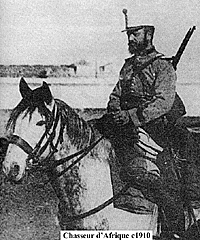 Spahis
Spahis
The term Spahis has two meanings. It can mean locally raised irregular levies, often organized into Goums and used as mercenary troops. References to small units of Spahis used in remote French outposts usually mean this. The Spahis Algeriens were a more formal regular cavalry along the lines of the Chasseurs d’Afrique. There were three regiments (until a fourth was added in 1911 after which the first three regiments became the Spahis Algeriens) used almost exclusively in detachments in much the same way as the Chasseurs.
Organization: Regular Spahis were organized on paper into three regiments of about 500 men. Organization was 4 squadrons per regiment. However, in the field they were almost always deployed in detachments of between 20 and 120 men depending on the task.
Uniforms:
Hat: Very large white burnous held in place with braids of camel hair.
Jacket: Bright red jacket and vest of the Zouave style. Black piping on the collar and down the front. Red camel hair cloak (haik). (Officers wore a French style red jacket with blue cuffs, black cavalry boots and a kepi). This uniform would be less formal in the field and the units on campaign took on a more “irregular” look (which is good, because we have yet to find a manufacturer that makes a 28-mm spahis).
Pants: Pale blue baggy sarouel pants with a red sash.
Equipment: Spahis were officially armed with only a saber until W.W.I. but there are pictures of them carrying carbines prior to this.
Irregulars
The Armee d’Afrique was supported by significant contributions from Irregular units. The Goums were indigenous irregular gendarmerie similar to the British Indian Army’s Scouts of the Northwest Frontier.
Goumiers
Goums usually fought within their own geographic regions particularly so in Algeria, but not always. The first Regular Goums (un-uniformed) were recruited in Morocco after 1907. Units of camel mounted irregulars, companies of Tirailleurs Sahariennes attached to companies of Tirailleurs Algeriens and were used for subduing the Tuat region. Despite some successes these were considered unreliable. It was intended to recruit the black haratin residents of the Kasars whom it was expected would rise up against their former masters. This turned out to be wishful thinking and the French ended up with a witless bunch totally unsuited to the harsh physical realities this type of unit requires. In 1902 they were replaced with the Compagnies Sahariennes.
Organization: Irregular goums totaled some 200 men consisting of a company of foot of about 120, 50 cavalry, a mule support section and later, an MG section of two guns. They were commanded by a French and Algerian cadre of one French captain with three lieutenants, eight French and eight Algerian NCO’s. In the more southerly operations the goums became somewhat smaller.
Uniforms: Irregular native dress.
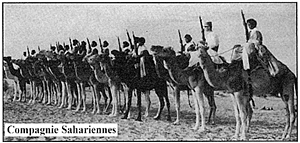 Compagnies Sahariennes were recruited from Chaamba Arabs and Tuaregs with a French cadre. They were very specialized in their operation and not strictly irregular in organization. Using strict selection methods and good pay, far more suitable applicants were attracted than had been with the Tirailleurs Sahariennes. These units covered staggering distances in the worlds harshest of environments, usually 50 miles per day but up to 100 miles in a single day in an emergency. The camels and horses were usually in tow, being preserved for battle at the end of the march.
Compagnies Sahariennes were recruited from Chaamba Arabs and Tuaregs with a French cadre. They were very specialized in their operation and not strictly irregular in organization. Using strict selection methods and good pay, far more suitable applicants were attracted than had been with the Tirailleurs Sahariennes. These units covered staggering distances in the worlds harshest of environments, usually 50 miles per day but up to 100 miles in a single day in an emergency. The camels and horses were usually in tow, being preserved for battle at the end of the march.
Small indigenous units of these were also used in the southern desert fringes. They would pursue Moroccan slave raiding razzias back into Morocco. Often allying themselves with tribes they would undertake raids on other more troublesome tribes. When an attack on a camp got under way and the murdering, raping and pillage started, the French officers would usually retire and leave the men to their own devices. On one such raid, a mehariste (cameleer) whose father had been murdered by the community that he was now engaged in “suppressing” rewarded himself with a necklace of testicles.
It was these companies that finally brought the southern tribes into the French fold. Organization: A French cadre of six officers from the Affaires Indigenes service commanded the Compagnies Sahariennes. They were usually mounted on ponies. They were supported by 36 other French NCO’s and specialists. The Tidikelt company contained 200 cameleers, 25 horsemen and 200 foot soldiers. The Tuat company was somewhat smaller with 60 cameleers, 12 horsemen and 85 foot with a proportionately smaller French cadre. Uniforms: No uniforms, irregular dress.
Artillery
France quickly gave up the idea of dragging heavy artillery around the desert and resorted to light pieces pulled by, or broken down and packed on mules. The most common piece being the 8cm-mountain gun of the Kruup design. These were operated usually by French personnel, even in Tirailleur regiments, but often with African handlers and ammunition carriers.
| Armee D'Afrique | |||||
|---|---|---|---|---|---|
| ORAN DIVISION | ALGIERS DIVISION | CONSTANTINE DIVISION | TUNISIAN DIVISION | ||
| 2e Brigade | 4e Brigade | 1er Brigade | 3e Brigade | 1er Brigade | 2e Brigade |
| 2e Zouave (Oran) | 1er Légion Etrangèr (Sidi-bel-Abbès) | 1re Zouaves (Algiers) | 1er Zouaves (Constantine) | 4e Zouaves (Tunis) | 4e Tirailleurs Algériens (Sousse) |
| 2e Tirailleurs Algériens (Mostaganem) | 2e Légion Etrangèr (Saida) | 1er Tirailleurs Algériens (Blida) | 3e Tirailleurs Algériens (Bône) | 5e Infanterie Légère (Kef) | 4e Infanterie Légère (Gabès) |
| - | 1er Infanterie Légère Battalion | - | - | - | - |
| - | - | 11e Bataillons d’Artillerie à pied (light pack artillery) (Algiers) | - | 3e Bataillons d’Artillerie à pied (light pack artillery) (Tunis) | - |
| 6e Chasseurs d’Afrique (Oran) | 2e Chasseurs d’Afrique (Tlemcen) | 1er et 5e Chasseurs d’Afrique (Blida & Algiers) | 3e Chasseurs d’Afrique (Constantine) | 4e Chasseurs d’Afrique (Tunis) | - |
| 4 Regiments (3 Algeriens, 1 Tunisiens) of Spahis served, mainly in detachments, throughout Africa | |||||
| Compagnies Sahariennes, 3 companies. In Salah (for the Tidikelt), Adrar (for the Tuat) and Timimoun (for the Gourara) (formerly the Saharan Spahis and Tirailleurs Sahariens - Disbanded 1902) | |||||
| Various ad hoc Irregular levies (Goums) raised throughout the region. | |||||
| Morocco was formally invaded in 1907. Prior to 1914 it did not have a formal garrison establishment but was staffed from units detached from XIX Corps. (After 1907 the Tirailleurs in Algeria and Tunisia were rapidly expanded to 9 regiments) | |||||
| WEST MOROCCO | EAST MOROCCO | SOUTH MOROCCO | |||
| Three battalions form 1er Zouaves Two bat’s each from 3e and 4e Zouaves 2e and 3e bat’s from Infanterie Légère Two bat’s from 2nd Légion Etrangèr 13 battalions from Tirailleurs Algériens (1 from 1er, 2 each from 3e, 5e & 7e, 3 each from 4e & 8e) | Two battalions for 2nd Zouaves 1er Battalion from Infanterie Légère Three battalions from 1er Légion Etrangèr Five battalions from Tirailleurs Algériens (3 from 2e, 1 from 6e, 1 from 9e) | One battalion from 6e Tirailleurs Algériens | |||
| The four Spahis Regiments also served in Morocco | |||||
More Resistance in the Desert Part I
-
Introduction
Invasion of Tidikelt
The Resistance Ferments
Problems of Supply
Overview of the Inhabitants of SE Morocco
Military and Political System of Dawi Mani' and Ait Atta
Kasar Inhabitants
Native Firepower in the Desert
French Forces in North Africa
Back to Table of Contents -- Courier #80
To Courier List of Issues
To MagWeb Master Magazine List
© Copyright 2000 by The Courier Publishing Company.
This article appears in MagWeb (Magazine Web) on the Internet World Wide Web.
Other military history articles and gaming articles are available at http://www.magweb.com